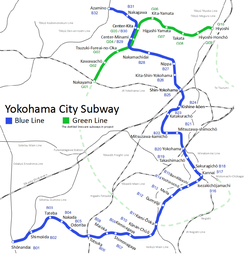Yokohama Municipal Subway
This article includes a list of generalreferences,butit lacks sufficient correspondinginline citations.(July 2018) |
| Yokohama Municipal Subway | |||
|---|---|---|---|
 | |||
| Overview | |||
| Native name | Hoành bang thị 営 địa hạ thiết Yokohama-shiei chikatetsu | ||
| Locale | Yokohama,Japan | ||
| Transit type | Rapid transit | ||
| Number of lines | 2 (Blue & Green) | ||
| Number of stations | 42 | ||
| Website | www | ||
| Operation | |||
| Began operation | December 16, 1972 | ||
| Operator(s) | Yokohama City Transportation Bureau | ||
| Technical | |||
| System length | 53.4 km (33.2 mi) | ||
| Track gauge | 1,435 mm(4 ft8+1⁄2in) | ||
| |||
Yokohama Municipal Subway(Hoành bang thị 営 địa hạ thiết,Yokohama-shiei chikatetsu)is therapid transitnetwork in the city ofYokohama,Japan, south of Tokyo inKanagawa Prefecture.It is operated byYokohama City Transportation Bureauas two lines, though three continuous lines exist.


Lines[edit]

| Symbol | Line | Name | First section opened | Last extension | Length km (miles) | Stations |
|---|---|---|---|---|---|---|
| Line 1 | Blue Line | 1972 | 1999 | 19.7 km (12.2 mi) | 17 | |
| Line 3 | 1985 | 1993 | 20.7 km (12.9 mi) | 16[Note 1] | ||
| Line 4 | Green Line | 2008 | - | 13.1 km (8.1 mi) | 10 | |
| Total: | 53.5 km (33.2 mi) | 42 | ||||
The Yokohama Municipal Subway consists of three lines: Line 1, Line 3 and 4. Line 1 and 3 are operated as a single line, nicknamed theBlue Line. Line 4 is nicknamed theGreen Line.Upon the addition to the network of this line on March 30, 2008, the Blue Line and Green Line monikers came into official use.
Transfer between the Blue and Green Line is possible atCenter-KitaandCenter-Minami Stations.Feeder bus services from westernKawasakiCity area run to Azamino Station.
The "missing" Line 2 was planned to run fromKanagawa-Shinmachi StationviaYokohama StationtoByobugaura Station.The 11.4 km (7.1 mi) line was previously considered as a bypass line for easing congestion on theKeikyū Main Line,however, the line deemed unnecessary after the Keikyu Line increased its capacity.[citation needed]
Blue Line[edit]
TheBlue Line(Lines 1/3) is operated as an integrated route of 40.4 kilometres (25.1 mi) betweenShōnandai StationinFujisawaandAzamino Station.The Blue Line is Japan's second-longest subway line, after the 40.7 km (25.3 mi)Toei Ōedo LineinTokyo.
In July 2011, a "mobile phone power off area" was set up in each car, and the use of mobile phones is officially banned except in other areas.
Green Line[edit]
TheGreen Line(Line 4) opened on March 30, 2008, betweenHiyoshi StationandNakayama Station,operating distance 13.0 km (8.1 mi) (total extension distance 13.1 km (8.1 mi)). It takes approximately 21 minutes from Hiyoshi station to Nakayama station.
Planned extensions[edit]
Blue Line[edit]
On 21 January 2020, Yokohama City andKawasaki Cityannounced the route and four new stations for the planned 6.5 km (4.0 mi) extension of the Blue Line from Azamino Station toShin-Yurigaoka Stationon theOdakyū Odawara Line.[1][2]Construction of this section is expected to complete by 2030.[1][2]In June 2020, the Transportation Bureau startedenvironmental impact asssesmentprocedures of the extension project.[3]
Green Line[edit]
The Green Line was built as part of alarger master planto construct acircular linein Yokohama. The full line will be a C-shaped line that stretches fromTsurumi Stationvia Hiyoshi Station, Nakayama Station,Futamata-gawa Station,Higashi-Totsuka Station,Kamiōoka Station,andNegishi StationtoMotomachi-Chūkagai Station.
Station numbering[edit]
Numerical designationsfor the stations on the Blue Line were introduced in 2002, coinciding with Yokohama city hosting the finals of the2002 FIFA World Cupand the subway's 30th anniversary, starting from Shonandai station (1) to Azamino station (32). With 32 stations on the line and 32 teams in the World Cup, each station was themed after a country. Alphabetical designations were added when the Green Line opened. The Blue Line stations are B01 through B32, while Green Line stations starts from Nakayama Station (G01) to Hiyoshi Station (G10). At two stations—Center-Minami Station and Center-Kita Station—where both lines overlap, a different station number is attached to each route.
Network Map[edit]
See also[edit]
- List of metro systems
- Minatomirai Line,a private subway line in Yokohama
- Transport in Greater Tokyo
Notes[edit]
- ^IncludingKannai Station
References[edit]
- ^ab"Hoành bang thị 営 địa hạ thiết ブルーラインの diên thân “あざみ dã ~ tân bách hợp ヶ khâu” khái lược ルート・ dịch vị trí が quyết định しました! "(PDF).City of Yokohama.2020-01-21.Retrieved2023-03-20.
- ^ab"Xuyên kỳ thị: Sự nghiệp kế họa の khái yếu".www.city.kawasaki.jp.Retrieved2023-03-20.
- ^"3 hào tuyến diên thân thủ tổ trạng huống".www.city.yokohama.lg.jp(in Japanese).Retrieved2023-03-20.
External links[edit]
- Transportation Bureau, City of Yokohama – official website(in English)
- Network map
- Yokohama Municipal Subway Map(in English)


